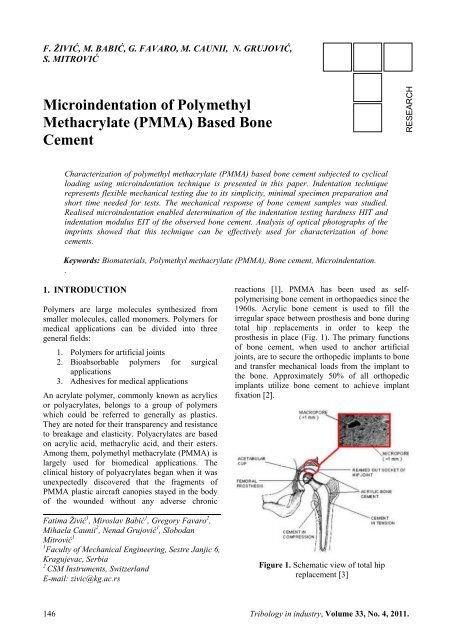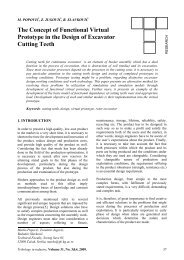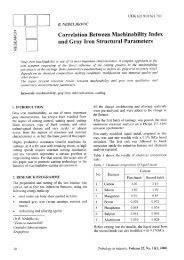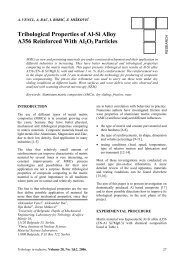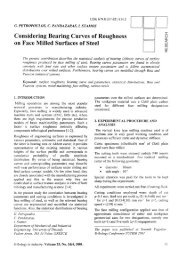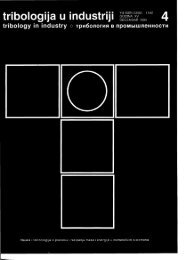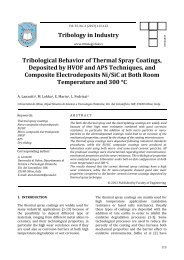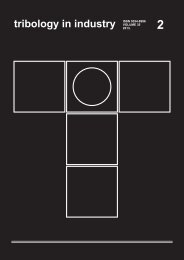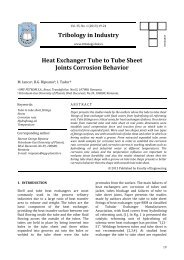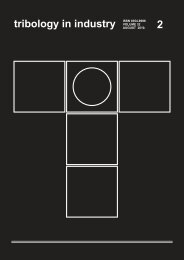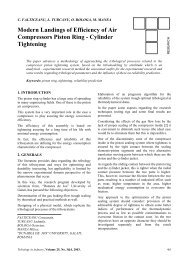(PMMA) Based Bone Cement - Tribology in Industry
(PMMA) Based Bone Cement - Tribology in Industry
(PMMA) Based Bone Cement - Tribology in Industry
Create successful ePaper yourself
Turn your PDF publications into a flip-book with our unique Google optimized e-Paper software.
F. ŽIVIĆ, M. BABIĆ, G. FAVARO, M. CAUNII, N. GRUJOVIĆ,S. MITROVIĆMicro<strong>in</strong>dentation of PolymethylMethacrylate (<strong>PMMA</strong>) <strong>Based</strong> <strong>Bone</strong><strong>Cement</strong>RESEARCHCharacterization of polymethyl methacrylate (<strong>PMMA</strong>) based bone cement subjected to cyclicalload<strong>in</strong>g us<strong>in</strong>g micro<strong>in</strong>dentation technique is presented <strong>in</strong> this paper. Indentation techniquerepresents flexible mechanical test<strong>in</strong>g due to its simplicity, m<strong>in</strong>imal specimen preparation andshort time needed for tests. The mechanical response of bone cement samples was studied.Realised micro<strong>in</strong>dentation enabled determ<strong>in</strong>ation of the <strong>in</strong>dentation test<strong>in</strong>g hardness HIT and<strong>in</strong>dentation modulus EIT of the observed bone cement. Analysis of optical photographs of theimpr<strong>in</strong>ts showed that this technique can be effectively used for characterization of bonecements.Keywords: Biomaterials, Polymethyl methacrylate (<strong>PMMA</strong>), <strong>Bone</strong> cement, Micro<strong>in</strong>dentation..1. INTRODUCTIONPolymers are large molecules synthesized fromsmaller molecules, called monomers. Polymers formedical applications can be divided <strong>in</strong>to threegeneral fields:1. Polymers for artificial jo<strong>in</strong>ts2. Bioabsorbable polymers for surgicalapplications3. Adhesives for medical applicationsAn acrylate polymer, commonly known as acrylicsor polyacrylates, belongs to a group of polymerswhich could be referred to generally as plastics.They are noted for their transparency and resistanceto breakage and elasticity. Polyacrylates are basedon acrylic acid, methacrylic acid, and their esters.Among them, polymethyl methacrylate (<strong>PMMA</strong>) islargely used for biomedical applications. Thecl<strong>in</strong>ical history of polyacrylates began when it wasunexpectedly discovered that the fragments of<strong>PMMA</strong> plastic aircraft canopies stayed <strong>in</strong> the bodyof the wounded without any adverse chronicFatima Živić 1 , Miroslav Babić 1 , Gregory Favaro 2 ,Mihaela Caunii 2 , Nenad Grujović 1 , SlobodanMitrović 11 Faculty of Mechanical Eng<strong>in</strong>eer<strong>in</strong>g, Sestre Janjic 6,Kragujevac, Serbia2CSM Instruments, SwitzerlandE-mail: zivic@kg.ac.rsreactions [1]. <strong>PMMA</strong> has been used as selfpolymeris<strong>in</strong>gbone cement <strong>in</strong> orthopaedics s<strong>in</strong>ce the1960s. Acrylic bone cement is used to fill theirregular space between prosthesis and bone dur<strong>in</strong>gtotal hip replacements <strong>in</strong> order to keep theprosthesis <strong>in</strong> place (Fig. 1). The primary functionsof bone cement, when used to anchor artificialjo<strong>in</strong>ts, are to secure the orthopedic implants to boneand transfer mechanical loads from the implant tothe bone. Approximately 50% of all orthopedicimplants utilize bone cement to achieve implantfixation [2].Figure 1. Schematic view of total hipreplacement [3]146<strong>Tribology</strong> <strong>in</strong> <strong>in</strong>dustry, Volume 33, No. 4, 2011.
Some drawbacks associated with <strong>PMMA</strong>-basedbone cements are: local tissue damage due tochemical reactions dur<strong>in</strong>g polymerization andstrong exothermic sett<strong>in</strong>g reaction, the highshr<strong>in</strong>kage of the cement after polymerization, thestiffness mismatch between bone and the cement,toxic effect of the monomer, <strong>in</strong>ability to bonddirectly to bone caus<strong>in</strong>g loosen<strong>in</strong>g at the <strong>in</strong>terfaceand brittle nature [2]. Loose cement particles alsomediate osteolysis of the bone and are highlyunwanted. Special problems occur at the <strong>in</strong>terfacesdue to the different elastic module of the materials(110 GPa for titanium, 2.2 GPa for <strong>PMMA</strong>, and 20GPa for bone) [3].The role of the cement is directly related to themechanical properties of the cement, especially theresistance to fracture of the cement <strong>in</strong> the mantle atthe cement-prosthesis <strong>in</strong>terface or the cement-bone<strong>in</strong>terface. Method of cement mix<strong>in</strong>g is veryimportant s<strong>in</strong>ce porosity is one of the crucialcharacteristics that determ<strong>in</strong>e its resistance tofracture. <strong>Cement</strong> that is <strong>in</strong>adequately mixedexhibits a high degree of porosity. High porositymeans that number of pores is present act<strong>in</strong>g asstress raisers and <strong>in</strong>itiat<strong>in</strong>g spots for cracks, furtherpromot<strong>in</strong>g early fatigue failure. Number of types ofbioactive bone cements has been <strong>in</strong>vestigated toovercome above listed problems.<strong>PMMA</strong> is one of the polymeric materials also usedas matrix for carbon fibers composites [1]. Carbonfiber has been recognized, recently, as a materialwith many excit<strong>in</strong>g applications <strong>in</strong> medic<strong>in</strong>e, s<strong>in</strong>cethey, when used as a re<strong>in</strong>forc<strong>in</strong>g materialsignificantly enhance the mechanical properties ofthe observed system. Orientation and fiber contentcan be varied <strong>in</strong> such a way to provide the implantwith mechanical property needed for properfunction<strong>in</strong>g. One common feature that implant mustsatisfy is its resistance to fatigue failure and to beresistant to attacks from the physiologicalenvironment [1]. Many new approaches have beentried to enhance mechanical properties of <strong>PMMA</strong>bone cements [4,5]. Recent methods <strong>in</strong>cludeaddition of re<strong>in</strong>forc<strong>in</strong>g particle or fiber <strong>in</strong> order to<strong>in</strong>crease cement stiffness, strength and toughness[4]. Common approach considers improvement offatigue characteristics, by re<strong>in</strong>forcement of <strong>PMMA</strong>with carbon fibers, hydroxyapatite particles,sta<strong>in</strong>less steel fibers, titanium fibers or zirconiaparticles or fibers, etc.A recognized issue is that it is not always possibleto dist<strong>in</strong>guish the medical-grade polymers from theconventional polymers. They are selected based onclean condition or trace element analysis ormechanical properties. Process<strong>in</strong>g <strong>in</strong>volve cleanroom conditions and special care not to contam<strong>in</strong>atethe materials.The ready bone cement is a compound consist<strong>in</strong>g of90% of polymethylmetacrylate, (<strong>PMMA</strong>), whichexists <strong>in</strong> an amorphous state and is completelytransparent. The rest are ma<strong>in</strong>ly crystals of bariumsulfate or Zirconium oxide that make the result<strong>in</strong>gproduct radio-opaque. The microscopic structure ofbone cement is made by two substances gluedtogether. One part consists of the small particles ofpre-polymerized <strong>PMMA</strong> (PolyMethylMetaAcrylate),so called “pearls”. These pearls are supplied as awhite powder. The other substance is a liquidmonomer of MMA (MethylMetacrylate). Bothsubstances are mixed together at the operation tablewith added catalyst that starts the polymerization ofthe monomer fluid. Amorphous polymers such as<strong>PMMA</strong> are brittle, hard plastics at roomtemperature [6]. It is isotropic and significantlybio<strong>in</strong>ert material. <strong>PMMA</strong> is attacked by m<strong>in</strong>eralacids but is resistant to alkalis, water and mostaqueous <strong>in</strong>organic salt solutions [6]. <strong>PMMA</strong> is alsosubject to both elastic and viscoelastic (creep)deformation under load [7]. Consider<strong>in</strong>g previouslystated, it is very important to properly def<strong>in</strong>emechanical characteristics of <strong>PMMA</strong> bonecements, to be able to further enhance theirfeatures.Characterization of bone cement to cyclical load<strong>in</strong>gis extremely significant and is a subject of manyongo<strong>in</strong>g studies [8-14]. For <strong>in</strong>stance, if total hipreplacement is considered, many daily activities<strong>in</strong>volve many cycles of different alternat<strong>in</strong>g load<strong>in</strong>gpatterns (walk<strong>in</strong>g, etc.). Studies showed that one ofthe ma<strong>in</strong> reasons of cement failure mechanism isrelated to fatigue failure and fatigue crackpropagation [8]. Indentation represents flexiblemechanical test<strong>in</strong>g due to its simplicity, m<strong>in</strong>imalspecimen preparation. It allows selection of loadsand tip geometry. Forces can be applied from kilonewtonsdown to nano-newtons, but alsodisplacements down to nanometer. Indentationresponse is related to specific aspects of materials<strong>in</strong> question (porous structure, biomaterials, etc.) and<strong>in</strong>terpretation of results requires specific knowledgeabout <strong>in</strong>dentation mechanics and physics of theobserved material [15]. The hardness of a materialis usually def<strong>in</strong>ed as the resistance to localdeformation [15]. Until development of<strong>in</strong>strumentation to accurately measure impr<strong>in</strong>tdimensions (contact area) after unload<strong>in</strong>g, hardnesstests were limited to macro scales. However, s<strong>in</strong>ce<strong>Tribology</strong> <strong>in</strong> <strong>in</strong>dustry, Volume 33, No. 4, 2011. 147
great advancements <strong>in</strong> this area, micro and nanoscale optical measurements are widely availablethus lead<strong>in</strong>g to expansion of <strong>in</strong>dentation<strong>in</strong>terpretation. Devices with depth sens<strong>in</strong>gpossibilities, such as CSM Nano Indentation Tester,enable determ<strong>in</strong>ation of hardness, elastic modulus,plastic stress-stra<strong>in</strong> behavior and/or creep behaviordirectly us<strong>in</strong>g the tester, without the need tomeasure contact impressions.2. PRINCIPLE OF INSTRUMENTEDINDENTATION TESTING (IIT)The Nano Indentation Tester uses an alreadyestablished method where an <strong>in</strong>denter tip with aknown geometry is driven <strong>in</strong>to a specific site of thematerial to be tested, by apply<strong>in</strong>g an <strong>in</strong>creas<strong>in</strong>gnormal load. When reach<strong>in</strong>g a pre-set maximumvalue, the normal load is reduced until partial orcomplete relaxation occurs. This procedure isperformed repetitively; at each stage of theexperiment the position of the <strong>in</strong>denter relative tothe sample surface is precisely monitored with adifferential capacitive sensor. For eachload<strong>in</strong>g/unload<strong>in</strong>g cycle, the applied load value isplotted with respect to the correspond<strong>in</strong>g positionof the <strong>in</strong>denter. The result<strong>in</strong>g load/displacementcurves (Fig. 2) provide data specific to themechanical nature of the material underexam<strong>in</strong>ation. Established models are used tocalculate quantitative hardness and elastic modulusvalues for such data.that describes the upper portion of the unload<strong>in</strong>gcurve by a power law relationship:where,F - is the test force,Fmax - is the maximum applied force,h - is the <strong>in</strong>dentation depth under applied test force,hp - is the permanent <strong>in</strong>dentation depth after theremoval of the test force,hmax - is the maximum <strong>in</strong>dentation depth at Fmax,m - is a power law constant exponent.The power law exponent m is determ<strong>in</strong>ed by a leastsquares fitt<strong>in</strong>g procedure and is a function of the<strong>in</strong>denter geometry.The contact stiffness S is given by the derivative atpeak load:And the tangent depth, hr, is thus given by:Where h r is the po<strong>in</strong>t of <strong>in</strong>tersection of the tangentc to curve b at F max with the <strong>in</strong>dentation depth-axis.The contact depth (depth of the contact of the<strong>in</strong>denter with the test piece at Fmax), h c , is then:where ε depends on the power law exponent m.The Indentation Test<strong>in</strong>g Hardness H IT isdeterm<strong>in</strong>ed from the maximum load, F max , dividedby the projected contact area A p at the contactdepth h c :Figure 2. Typical Load/displacement curveEvaluation of elastic modulus and hardness us<strong>in</strong>g<strong>in</strong>strumented <strong>in</strong>dentation is realised by the methoddeveloped and proposed by Oliver and Pharr. It isthe most common approach to determ<strong>in</strong>e hardnessand modulus by <strong>in</strong>terpretation of load - penetrationdepth (F - h) behavior dur<strong>in</strong>g <strong>in</strong>dentation (Fig. 1).Oliver and Pharr developed Power Law MethodWhere hc is the depth of the contact of the <strong>in</strong>denterwith the test piece at F max . A p (h c ) is the projectedarea of contact of the <strong>in</strong>denter at distance h c fromthe tip. A p is a function of the contact depth h c andis determ<strong>in</strong>ed by a calibration of the <strong>in</strong>denter tip.The Vickers Hardness HV is def<strong>in</strong>ed by:148<strong>Tribology</strong> <strong>in</strong> <strong>in</strong>dustry, Volume 33, No. 4, 2011.
3. EXPERIMENTAL TESTWhere Ac is the developed contact area and can becalculated from the projected contact area A p andthe <strong>in</strong>denter geometry as:Where α is the angle between the axis of thediamond pyramid and its faces, α = 68° for aVickers <strong>in</strong>denter (Fig. 3) and α = 65.27° for amodified Berkovich <strong>in</strong>denter.For Vickers <strong>in</strong>denter: HV = 0.0945 H ITFor modified Berkovich <strong>in</strong>denter: HV = 0.0926 H IT<strong>Bone</strong> cement prepared from commercially availabletype of mixture was used as a sample material for<strong>in</strong>dentation tests. <strong>PMMA</strong> is isotropic, show<strong>in</strong>g nocrystall<strong>in</strong>ity, elasto-viscoplastic solid andamorphous polymer. Several <strong>in</strong>dentations havebeen performed on each sample us<strong>in</strong>g the CSMMicro Indentation Tester (Fig. 4). Indentation testlasted for 300 cycles. Tests were performed withmaximum normal load of 15 N, m<strong>in</strong>imum load of 5N and approach speed of 5000 nm/m<strong>in</strong>.Vickers <strong>in</strong>denter was applied with quadraticload<strong>in</strong>g type. There was no pause at maximum loadbefore unload<strong>in</strong>g. Displacement measurementswere realised us<strong>in</strong>g LVDT sensor which is a part ofthe tester. Maximum possible <strong>in</strong>dentation depth waslimited to 200 µm with displacement resolution of0.3 nm.Figure 3. CSM Micro <strong>in</strong>strumented <strong>in</strong>dentationtest<strong>in</strong>g: a) Optical micrograph of a Vickers<strong>in</strong>dentation <strong>in</strong>to a standard steel reference sample;b) Detail of Vickers <strong>in</strong>denter mounted abovesampleIndentation Modulus E ITThe reduced modulus of the <strong>in</strong>dentation contact, E r ,is given by:Where β is a geometric factor depend<strong>in</strong>g on thediamond shape (circular: β = 1, triangular: β =1.034, square: β = 1.012). The Young’s modulus ofthe sample, E IT , can then be obta<strong>in</strong>ed from:Figure 4. a) CSM Micro Indentation Testerb) Schematic view of the ma<strong>in</strong> elements of MicroIndentation TesterWhereν i is the Poisson’s ratio of the <strong>in</strong>denter.ν s is the Poisson’s ratio of the sample.E i is the modulus of the <strong>in</strong>denter.4. RESULTS AND DISCUSSIONIndentation curve, that is, diagram of the normalforce applied dur<strong>in</strong>g micro <strong>in</strong>dentation as a functionof the number of cycles is shown <strong>in</strong> Fig. 5. This isclassical fatigue mode of <strong>in</strong>dentation test<strong>in</strong>g,<strong>Tribology</strong> <strong>in</strong> <strong>in</strong>dustry, Volume 33, No. 4, 2011. 149
whereas the force is loaded and unloaded constantlydur<strong>in</strong>g <strong>in</strong>dentation without a pause. Material issubjected to constant load/unload pattern and is notleft to rest, such as <strong>in</strong> case of <strong>in</strong>dentation mode oftest<strong>in</strong>g on creep.Figure 5. Normal force versus penetration depthcurve dur<strong>in</strong>g micro <strong>in</strong>dentationImpr<strong>in</strong>t on bone cement sample after <strong>in</strong>dentationlast<strong>in</strong>g for 300 cycles, is shown <strong>in</strong> Fig. 6. Typicalpattern produced by Vickers <strong>in</strong>dentation is clearlyseen. Detailed view of the left lower angle is shown<strong>in</strong> Fig. 6b. The impr<strong>in</strong>t is well shaped with clearlydeveloped edges and no microcracks around angles.This is <strong>in</strong> consistence with the fact that amorphousmaterials usually present an elastic behavior up tofailure [16]. Permanent deformation occurs due tohigh shear and compressive stresses which are bothpresent <strong>in</strong> highly localized area.Calculated values of hardness H IT and elasticmodulus E IT of bone cement sample after 300cycles obta<strong>in</strong>ed by the <strong>in</strong>dentation tester is shown<strong>in</strong> Table 1.Figure 6. a) Micrograph of the <strong>in</strong>dentation impr<strong>in</strong>ton bone cement after 300 cycles, b) Detail of the<strong>in</strong>dentation impr<strong>in</strong>t on <strong>PMMA</strong> after 300 cycles (leftbottom angle)Table 1. Values of hardness H IT and elasticmodulus E IT of bone cement sample after 300cycles obta<strong>in</strong>ed by the <strong>in</strong>dentation testerValue for <strong>PMMA</strong>sample after 300 cyclesHardness, H IT [MPa] 162.84Elastic modulus, E IT [GPa] 2.74Hardness profile and elasticity profile dur<strong>in</strong>gmulticycl<strong>in</strong>g load<strong>in</strong>g, unload<strong>in</strong>g and reload<strong>in</strong>g areshown <strong>in</strong> Fig. 7. Values given <strong>in</strong> Table 1 areautomatically calculated by the tester accord<strong>in</strong>g toOliver and Pharr approach, by analys<strong>in</strong>g theunload<strong>in</strong>g curves (Fig. 5). It can be clearly seen thatE IT value is rather uniform, whereas hardness hasslightly decreas<strong>in</strong>g trend.Figure 7. Hardness, H IT and elasticity, as a functionof the number of cycles dur<strong>in</strong>g micro <strong>in</strong>dentationLoosen<strong>in</strong>g is recognized as one of the primarysources of total hip replacement failure. One of thema<strong>in</strong> reasons is considered to be fatigue failure ofthe implant-bone cement and bone cement - bone<strong>in</strong>terface. That is the reason why characterization of150<strong>Tribology</strong> <strong>in</strong> <strong>in</strong>dustry, Volume 33, No. 4, 2011.
one cement to cyclical load<strong>in</strong>g is extremelysignificant and is a subject of many ongo<strong>in</strong>g studies[8-14]. Also, <strong>PMMA</strong> has been widely used as amodel for studies of fatigue and fracture <strong>in</strong>polymers. Effects of different factors have been<strong>in</strong>vestigated, whereas variable amplitude load<strong>in</strong>goffer <strong>in</strong>sight <strong>in</strong> its behavior from aspects of fatigueand crack propagation. The load<strong>in</strong>g curve <strong>in</strong> Fig. 5consists of both elastic and plastic contribution,while the unload<strong>in</strong>g curve is purely elastic andallows calculations of elastic modulus andhardness. <strong>Bone</strong> cements have a more complicatedstructure if compared to pure <strong>PMMA</strong>, withpreviously polymerised beads <strong>in</strong> a softer matrixwhich cures on implantation, and other componentssuch as particles of barium sulphate or zirconia tomake the cement visible <strong>in</strong> radiographs. Thismicrostructural complexity means that the cementmay behave very differently from pure <strong>PMMA</strong>.There are several commercially available bonecement mixtures and they have beencomprehensively studied both <strong>in</strong> laboratory andcl<strong>in</strong>ical practice. However, there are still featuresthat need to be enhanced and <strong>in</strong>dentation tests canbe used for further understand<strong>in</strong>g of its behavior.Cl<strong>in</strong>ical failure of the cement occurs over long timeperiods, and this implies that the crack growth rateis very low, perhaps as low as 10 -12 m/cycle. It isclear from Fig. 6 that cracks did not occur <strong>in</strong> thistest<strong>in</strong>g and that edges are smooth and clearlymarked with well shaped impr<strong>in</strong>t. Therefore, valuesof hardness H IT and elastic modulus E IT of bonecement sample can be taken as valid. Micro<strong>in</strong>dentation method can be used for measur<strong>in</strong>g ofelastic modulus and hardness of prepared bonecement mixtures <strong>in</strong> a short period of time.5. CONCLUSIONCharacterization of bone cement to cyclical load<strong>in</strong>g isextremely significant and is a subject of manyongo<strong>in</strong>g studies. Studies showed that one of the ma<strong>in</strong>reasons of cement failure mechanism is related tofatigue failure and fatigue crack propagation.Indentation represents flexible mechanical test<strong>in</strong>g dueto its simplicity, m<strong>in</strong>imal specimen preparation andshort time needed for tests. Devices with depthsens<strong>in</strong>g possibilities, such as CSM Nano IndentationTester, enable determ<strong>in</strong>ation of hardness, elasticmodulus, plastic stress-stra<strong>in</strong> behavior and/or creepbehavior directly us<strong>in</strong>g the tester, without the need tomeasure contact impressions.Results obta<strong>in</strong>ed with<strong>in</strong> this study were fullycomparable with the literature data found for <strong>PMMA</strong>and commercial bone cements. Micro <strong>in</strong>dentationmethod can be used for measur<strong>in</strong>g of elastic modulusand hardness of prepared bone cement mixtures. Veryimportant feature of CSM Micro <strong>in</strong>denter is automaticrecord<strong>in</strong>g of optical photographs of realised impr<strong>in</strong>ts.REFERENCES[1] J. Black, G. Hast<strong>in</strong>gs, Ed., Handbook ofBiomaterial Properties, Chapman & Hall, 1998[2] P.A. Revell, Editor, Jo<strong>in</strong>t replacementtechnology, Woodhead Publish<strong>in</strong>g Limited, 2008[3] J. D. Enderle, J.D. Bronz<strong>in</strong>o, S. M. Blanchard.,Introduction to biomedical eng<strong>in</strong>eer<strong>in</strong>g,Elsevier Academic Press, 2005[4] R. J. Kane, W.Y. James, J. Mason, R.K.Roeder, Improved fatigue life of acrylic bonecements re<strong>in</strong>forced with zirconiafibers, Journal of the Mechanical Behavior ofBiomedical Materials, Vol. 3, (2010) 504-511[5] Y.H. Nien, C. Huang, The mechanical study ofacrylic bone cement re<strong>in</strong>forced with carbonnanotube, Materials Science and Eng<strong>in</strong>eer<strong>in</strong>g:B, Vol. 169 (2010) 134-137[6] M. Kutz Editor, Biomedical Eng<strong>in</strong>eer<strong>in</strong>g andDesign Handbook, Vol. 1, McGraw-Hill, 2009[7] Lu Z, McKellop H., Effects of cement creep onstem subsidence and stresses <strong>in</strong> the cementmantle of a total hip replacement, Journal ofBiomedical Materials Research, 34 (1997)221–226[8] S. L. Evans, Fatigue of <strong>PMMA</strong> <strong>Bone</strong> <strong>Cement</strong>,Fracture of Nano and Eng<strong>in</strong>eer<strong>in</strong>g Materialsand Structures, B., Spr<strong>in</strong>ger, DOI: 10.1007/1-4020-4972-2_133, pp. 271-272, 2006[9] Arola D, Stoffel KA, Yang DT., Fatigue of thecement/bone <strong>in</strong>terface: the surface texture ofbone and loosen<strong>in</strong>g, Journal of BiomedicalMaterials Research Part B: Applied Biomaterials,76B: 287–297, Wiley Periodicals, 2005[10] G. Lewis, Fatigue Test<strong>in</strong>g and Performance ofAcrylic <strong>Bone</strong>-<strong>Cement</strong> Materials: State-of-the-Art Review, Journal of Biomedical MaterialsResearch Part B: Applied Biomaterials, 66B:457–486, Wiley Periodicals, 2003[11] D. A. Gorham, A. D. Salman, M. J. Pitt, Staticand dynamic failure of <strong>PMMA</strong> spheres,Powder Technology, Vol. 138, (2003) 229-238[12] B. J. Briscoe, A. Chateaum<strong>in</strong>ois, T. C. L<strong>in</strong>dley,D. Parsonage, Contact damage of<strong>Tribology</strong> <strong>in</strong> <strong>in</strong>dustry, Volume 33, No. 4, 2011. 151
poly(methylmethacrylate) dur<strong>in</strong>g complexmicrodisplacements, Wear, 240 (2000) 27-39[13] T. A. Stolarski, H. Williams, Mode of load<strong>in</strong>gand contact configuration effects <strong>in</strong> the wear ofpolymers, Journal of Applied Polymer Science,61 (1996) 1217–1222[14] D. Arola, K. A. Stoffel, D. T. Yang, Fatigue ofthe <strong>Cement</strong>/<strong>Bone</strong> Interface: The Surface Textureof <strong>Bone</strong> and Loosen<strong>in</strong>g, Journal of BiomedicalMaterials Research Part B: AppliedBiomaterials, Vol. 76B (2005) 287-297[15] A. Gouldstone, N. Chollacoop, M. Dao, J. Li,A.M. M<strong>in</strong>or, Y.L. Shen, Indentation acrosssize scales and discipl<strong>in</strong>es: Recentdevelopments <strong>in</strong> experimentation andmodel<strong>in</strong>g, Acta Materialia, Vol. 55 (2007)4015-4039[16] F. Petit, V. Vandeneede, F. Cambier,Relevance of <strong>in</strong>strumented micro-<strong>in</strong>dentationfor the assessment of hardness and Young'smodulus of brittle materials, Materials Scienceand Eng<strong>in</strong>eer<strong>in</strong>g: A, Vol. 456, (2007) 252-260152<strong>Tribology</strong> <strong>in</strong> <strong>in</strong>dustry, Volume 33, No. 4, 2011.


